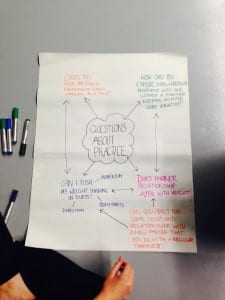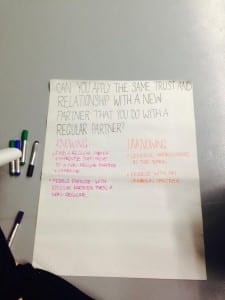When I was standing still, I didn’t realise how much my body was in constant motion. I became aware of how my reflexes were communicating with gravity, muscles and the bones to stay in alignment. With minimal muscular effort, I became aware that my body reflexes were action to help prevent me from falling. In a stand still position, I felt myself losing balance and I found myself continuously wanting to move forward. As I was very conscious of losing my balance, I held a lot of tension in my calves and they appeared to be quite stiff as I felt this was necessary in order for me to regain my alignment. However, this is known as Steve Paxton’s notion of the ‘Small Dance’. The small dance is ‘continuously losing balance and regaining a new balanced alignment through the activity of body reflexes’, therefore leading the small dance to be a ‘unpredictable pattern of momentum and readjustment that travels through the body’.
We developed the small dance further and explored how we could take ourselves off balance. Initially, the momentum of my body directed my to run a few steps forward or backwards in the space. I realised that I held a lot of tension in my body because I was afraid of letting go but I soon began to think unconsciously and listen to my body impulses to direct in the direction it wanted to move. At first I was a bit apprehensive but then I found myself moving in different directions, such as forwards, backwards, to the side, diagonally and moving towards the floor. I soon realised that I would not injury myself because the ground would always be there to catch me and I wasn’t a far distance from the ground at all, which therefore led me to experiment more with the possibilities of the small dance.
The next exercise consisted of each partner taking the role of the cat and the cat owner. Whilst one partner acted as the cat owner, presenting a supportive base for the other partner, the other partner would act as the cat, using different surfaces of their partner’s body to explore how they could give them their weight. In pursuing this task, I found it very interesting because I found myself trying things that I haven’t done before and I was open to a lot more possibilities. Usually, I am reluctant to taking the role of the over dance because I am concious of hurting others or potentially giving them my full body weight. However, I came to realisation that after the small dance task, nothing drastic would happen if I gave my partner my body weight. This is because if I was to fall, the ground would always catch me and then I can experiment with different movement instead, as I believe a crucial part of contact improvisation is exploration. Using Kelly as a supportive base, I found myself using different body parts instead of the feet and hands, such as my knees, legs, hips and back to explore how I could give my weight to her. As the exercise continued, I grew in confidence to explore with more things. I knew that Kelly was there to support me and would move around me to act as base so I wouldn’t hurt her and this also allowed me to have more time to think of how I could her my weight. Therefore, this enabled me to step away from my reluctance and lift my feet of the ground and use other body parts to balance with and even roll over her.
Our final task was to perform a duet in our partners, alternating between the roles of the cat and cat owner. Both Kelly and I found this an easier task and it allowed us to listen to each other’s body impulses without taking much time to consciously think about how we could move. As we were alternating between roles, the momentum and pace of the performance increased, which therefore allowed me to experiment with both roles as the under and over dancer, as I realised there was even more scope for experimentation without consciously thinking about what I was going to do. By alternating between roles, it allowed me to see how I could use different ways to give my partner my weight and support their weight. For example, I supported Kelly’s weight with different body parts to usual, such as my hips and back and supported her on a higher level by going on all fours. This also led my to give my weight to Kelly at a higher level. Throughout this task, I allowed myself to become aware of Kelly’s weight and body impulses to move in a safe manner. This became evident in the jam session, as I tried to work with people that I don’t usually work with, alternating between the roles of the under and over dancer and allowing myself to become more trustworthy so I could become more experimental. However, I feel that I need to experiment more with movement standing up rather than keeping movement at a lower level, as this is a habitual pattern of mine. The darkness of the room also made the whole improvisation session easier as I didn’t have a chance to think who I was dancing with and I found myself improvising a cluster of people, which is normally something I don’t do. Throughout the lessons, I had intentions of exploring with weight further, allowing myself to give people my weight rather than receiving it and I felt I achieved this in the jam session as I pushed myself more. This because I didn’t worry about the consequences, I let go off any tension, allowed myself to be more relaxed and became more experimental in the way I was reacting to others.
Towards the end of the lesson, we formulated a research lab in groups and discussed a variety of topics that we wanted to explore further within the next few contact improvisation sessions.
Bibliography
Ravn, S. (2010) Sensing Weight in Movement. Journal of Dance & Somatic Practices, 2(1)21-34.
Brown, B. (1997) Is Contact a Small Dance? Contact Improvisation Sourcebook, 1(6)72-75.
Hassmann, J. (2009) Explorations within the Small Dance. [online] Available from http://www.contactquarterly.com/contact-improvisation/webtexts/view/explorations-within-the-small-dance.php [Accessed 17 October 2014].

